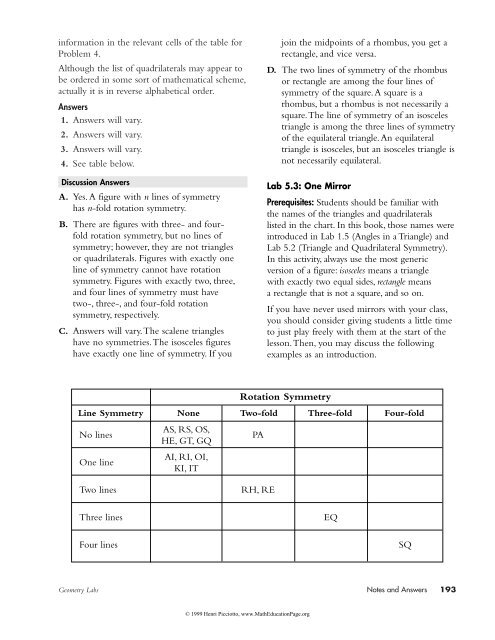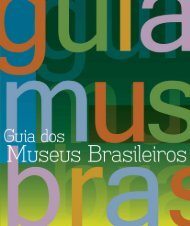You also want an ePaper? Increase the reach of your titles
YUMPU automatically turns print PDFs into web optimized ePapers that Google loves.
information in the relevant cells of the table for<br />
Problem 4.<br />
Although the list of quadrilaterals may appear to<br />
be ordered in some sort of mathematical scheme,<br />
actually it is in reverse alphabetical order.<br />
Answers<br />
1. Answers will vary.<br />
2. Answers will vary.<br />
3. Answers will vary.<br />
4. See table below.<br />
Discussion Answers<br />
A. Yes. A figure with n lines of symmetry<br />
has n-fold rotation symmetry.<br />
B. There are figures with three- and fourfold<br />
rotation symmetry, but no lines of<br />
symmetry; however, they are not triangles<br />
or quadrilaterals. Figures with exactly one<br />
line of symmetry cannot have rotation<br />
symmetry. Figures with exactly two, three,<br />
and four lines of symmetry must have<br />
two-, three-, and four-fold rotation<br />
symmetry, respectively.<br />
C. Answers will vary.The scalene triangles<br />
have no symmetries.The isosceles figures<br />
have exactly one line of symmetry. If you<br />
join the midpoints of a rhombus, you get a<br />
rectangle, and vice versa.<br />
D. The two lines of symmetry of the rhombus<br />
or rectangle are among the four lines of<br />
symmetry of the square.A square is a<br />
rhombus, but a rhombus is not necessarily a<br />
square.The line of symmetry of an isosceles<br />
triangle is among the three lines of symmetry<br />
of the equilateral triangle.An equilateral<br />
triangle is isosceles, but an isosceles triangle is<br />
not necessarily equilateral.<br />
Lab 5.3: One Mirror<br />
Prerequisites: Students should be familiar with<br />
the names of the triangles and quadrilaterals<br />
listed in the chart. In this book, those names were<br />
introduced in Lab 1.5 (Angles in a Triangle) and<br />
Lab 5.2 (Triangle and Quadrilateral Symmetry).<br />
In this activity, always use the most generic<br />
version of a figure: isosceles means a triangle<br />
with exactly two equal sides, rectangle means<br />
a rectangle that is not a square, and so on.<br />
If you have never used mirrors with your class,<br />
you should consider giving students a little time<br />
to just play freely with them at the start of the<br />
lesson.Then, you may discuss the following<br />
examples as an introduction.<br />
Rotation Symmetry<br />
Line Symmetry None Two-fold Three-fold Four-fold<br />
No lines<br />
One line<br />
Two lines<br />
AS, RS, OS,<br />
HE, GT, GQ<br />
AI, RI, OI,<br />
KI, IT<br />
PA<br />
RH, RE<br />
Three lines<br />
EQ<br />
Four lines<br />
SQ<br />
Geometry Labs Notes and Answers 193<br />
© 1999 Henri Picciotto, www.MathEducationPage.org






